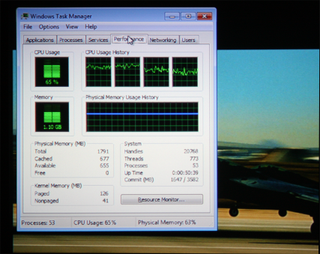Editor's Corner: Nvidia’s Ion Revisited, 7.1 Ch. LPCM Fixed
Using Ion. I Mean Really Using It.
It’d be easy to set this platform up on an open-air test bench, marvel at its size, rattle off its specs, run a couple of benchmarks that show it to be better than Intel’s own Atom-based boards, and give it an award. There’s nothing wrong with open-air testing. There’s nothing wrong with specs, benchmarks, or awards, for that matter. But you’re not going to get the feel of this diminutive little box unless you use it.
So, with a HTPC usage model in mind and the issues first encountered in our review addressed, I built up a mini-ITX system around Zotac’s Ion offering, using Windows 7, 2 GB of DDR2 memory, an OCZ SSD, and a slim Blu-ray player that Nvidia was kind enough to send along.

Let’s start with DVD playback. This is one area where the Ion is destined to shine given its GPU-based hardware capabilities. I played through several Blu-ray titles with Dolby TrueHD and DTS-HD Master Audio, and they were delivered smoothly. Though my modest theater room isn’t large enough for 7.1-channel sound to make sense, PowerDVD 9 had no trouble decoding the latest lossless codecs and outputting a 5.1-channel LPCM stream to my Onkyo SR507.
All in all, as a platform for playing movies, Ion handles business—though once you’re done buying storage, memory, and a chassis, I almost wonder if it wouldn’t be easier to just grab that Playstation instead.

Next up is TV programming. I don’t watch any cable television, but I do hit Hulu on occasion when I eat dinner in front of the PC. The site employs Adobe Flash 9, which is going to need to be processed on the dual-core Atom processor. And indeed, this becomes a problem. In watching the pilot for Glee, it simply wasn’t possible to go full-screen at either low-res (320p) or high-res (480p) on my 50” Samsung running at 1280x720 (in the words of my wife, “It’s too distracting to try watching like this Let me know when you’re done playing around”). The standard browser window mode worked fine, but from 10 feet away, you’re really defeating the purpose of pulling this platform into a home theater environment.
Of course, I didn’t expect .mp3 playback to be an issue, so I tried to give the Ion setup a slightly more challenging task constrained by I/O performance instead: streaming audio wirelessly from a NAS attached to the network via Gigabit Ethernet, while indexing a folder in the background. This is something that happens almost-transparently on most desktops; however, it brought this HTPC build to a stuttering stand-still (even with an SSD).

Purpose-Built HTPC, Perhaps
Stay on the Cutting Edge
Join the experts who read Tom's Hardware for the inside track on enthusiast PC tech news — and have for over 25 years. We'll send breaking news and in-depth reviews of CPUs, GPUs, AI, maker hardware and more straight to your inbox.
Fortunately for me, movies are all I really do in the theater room. For that purpose, Ion works. And it’s hard to argue against the board’s form factor (though, to that end, I’m still a fan of the LGA-775 mini-ITX alternative). Keep your expectations in line on this one, though. Any time you’re not taking advantage of the GeForce 9300’s GPU acceleration, you’re at the mercy of Intel’s Atom CPU. On the desktop, that’s really a recipe for frustration.
-
amnotanoobie So I guess with the falling prices of processors and video cards, you'd really get an Ion only if you're really just constrained with space.Reply
-
snarfies I'd love an Ion, but it has a design flaw - only three HD connections. I need at least four - one CF-Card for the OS, two HDs for RAID1, and one optical. As near as I can tell, the only ITX board on the market that fits my needs is the MSI IM-945GC - which is what I'm currently using for my ITX NAS.Reply -
hixbot Wow, one of the first boards to deliver video and 7.1 LPCM via HDMI, and you test it with a 5.1 setup? How can you be sure you tested it's functionality, if you are using a 5.1 setup? Please elaborate.Reply -
hixbot Also, CoreAVC have released a decoder that can use CUDA to accelerate playback. From what i've heard, its much better than DXVA and has none of the format limitations. Some testing with that would be great to see. Or is Tom's opposed to open source?Reply -
cangelini Hix,Reply
Without a 7.1 channel setup, the best option available is setting 7.1-channel output and missing the two side channels, which works. The problem previously was that Ion was only doing stereo LPCM, despite being set to 5.1/7.1 in Windows. This was a shortcoming of the DVD playback software, which, as I mentioned, has since been fixed to properly support this board's capabilities.
Thanks for the feedback,
Chris -
cangelini hixbotAlso, CoreAVC have released a decoder that can use CUDA to accelerate playback. From what i've heard, its much better than DXVA and has none of the format limitations. Some testing with that would be great to see. Or is Tom's opposed to open source?Reply
So it looks like the $15 version of the software supports what you're talking about. I'll look into it! Thanks for the tip,
Chris -
dravis12 Glad to read this review. I'm building a new HTPC and decided against the Ion/Atom platform in favor of a 9300/C2 Duo because I heard about the problems with Hulu and the current limitations of the Atom. Looks like I made the right choice for now but we'll see.Reply -
Niva I'll be building an HTPC sometime early next year and I'm glad to have seen these articles as I had been considering an ION. Now I'm not sure what I'll get but perhaps a full low power athlon x2 setup will do it for me.Reply
Most Popular


